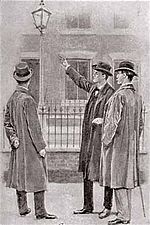The Adventure of the Six Napoleons
| "The Adventure of the Six Napoleons" | |
|---|---|

Holmes pointing to a street lamp, 1904 illustration by Sidney Paget
|
|
| Author | Arthur Conan Doyle |
| Series | The Return of Sherlock Holmes |
| Publication date | 1904 |
"The Adventure of the Six Napoleons", one of the 56 Sherlock Holmes short stories written by British author Sir Arthur Conan Doyle, is one of 13 stories in the cycle collected as The Return of Sherlock Holmes.
Inspector Lestrade of Scotland Yard brings Holmes a seemingly trivial problem about a man who shatters plaster busts of Napoleon. One was shattered in Morse Hudson’s shop, and two others, sold by Hudson to a Dr. Barnicot, were smashed after the doctor’s house and branch office had been burgled. Nothing else was taken. In the former case, the bust was taken outside before being broken.
Holmes knows that Lestrade’s theory about a Napoleon-hating lunatic must be wrong. The busts in question all came from the same mould. Why is he breaking them?
The next day, Lestrade calls Holmes to a house where there has been yet another bust-shattering, but there has also been a murder. Mr. Horace Harker found the dead man on his doorstep after investigating a noise. His Napoleon bust was also taken by a burglar entering through a window. It, too, was from the same mould. Also, a photograph of a rather ape-ish-looking man is found in the dead man’s pocket.
The fragments of Harker's bust are in the front garden of an empty house up the street. Obviously the burglar wanted to see what he was doing, for there is a streetlamp here, whereas the bust could have been broken at another empty house nearer Harker’s, but it had been dark there.
Holmes tells Lestrade to tell Harker, a journalist for the Central Press Syndicate, that he is convinced that the culprit is a lunatic. Holmes knows that this is not true, but it is expedient to use the press to convince the culprit that this is what the investigators believe.
Holmes interviews the two shopkeepers who sold the busts and finds out whom they were sold to, and where they were made, Gelder & Co. A couple of his informants also recognize the ape-ish man in the picture. They know him as Beppo, an Italian immigrant. He even worked in the shop where the first bust was broken, having left his job there only two days earlier.
Holmes goes to Gelder & Co. and finds out that the busts were part of a batch of six, but other than that, the manager can think of no reason why they should be special, or why anyone would want to destroy them. He recognizes Beppo’s picture, and describes him as a rascal. He was imprisoned for a street-fight stabbing a year earlier, but has likely been released now. He once worked at Gelder & Co., but has not been back. His cousin still works there. Holmes begs the manager not to talk to the cousin about Beppo.
...
Wikipedia
